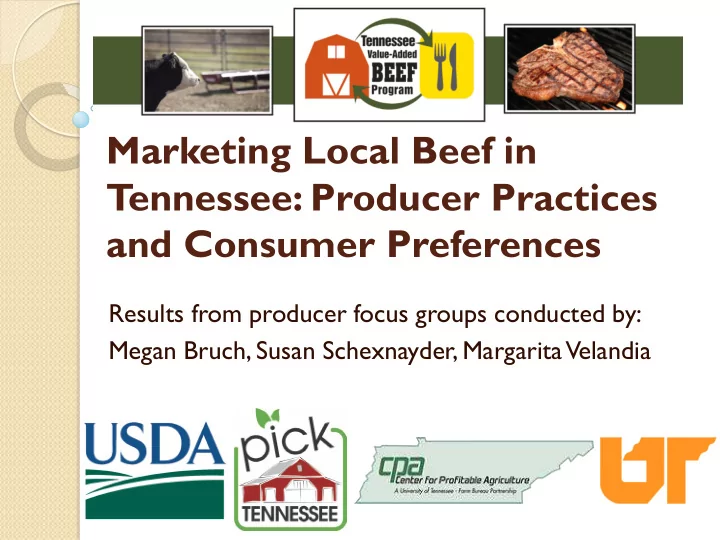

Marketing Local Beef in T ennessee: Producer Practices and Consumer Preferences Results from producer focus groups conducted by: Megan Bruch, Susan Schexnayder, Margarita Velandia
Participant’s Profiles 26 Participants 18 Farms 14 12 12 10 8 8 7 # of participants 6 6 # of farms 6 5 4 2 0 Murfreesboro Pleasant View Pigeon Forge
Participants’ Profile Characteristics Average Range Acres Farm: Lease (acres) 331 25-1000 (10 leased 0 acres) Own (acres) 312 5-1400 (1 owned 0 acres) Years Marketing 8 months – 50 8.3 Beef to Consumers years Approx. Head of Cattle Marketed as 28 3-120 Meat to Consumers in Last 12 Months
Participants’ Profile Other products sell directly to consumers – 5 only sold beef
Market Channels Farmers Markets ( 55%) From the farm (55%) Specialty Grocers – Butcher Shops (22%) Restaurants (22%) CSAs (11%) LocalHarvest.org (5%) On-line Sales
Farmers Markets PROS CONS Price set by farmer Time consuming and time away from farm Builds a pool of repeat customers Farmers markets (FM) are seasonal/ through building relationships FM season overlap not ideal with best slaughter time Exposure/Opportunity to build Logistics may be a challenge relationships with other potential (loading/unloading, transportation, buyers (Restaurants, CSAs) electricity sources, booth set up) Facilitates consumer education Time investment in building buyers’ trust / Educating consumers on product safety Sales variability due to weather and demand
From the Farm PROS CONS Good opportunity for producers with May be difficult to acquire new customers established customer base Good Margins - small transaction costs, Remote farm locations may diminish price set by farmer opportunities for on-farm sales Immediate payment May require large freezer storage space Facilitate year-round sales Additional investments to guarantee a positive customer experience (bathrooms, farm appearance) Opportunity to sell other products and Liability of having customers on the farm services Ability to plan a “market” day Scheduling appointments may be challenging Ability to offer more variety of cuts Lower labor/time Ability to better set visit time, payment types, expectations of visit
On-line Sales PROS CONS Potential to reach a large Additional effort to pool of potential customers maintain consistent customer base Facilitates delivery Expensive packing and information shipping
Specialty Grocers/Butcher Shops PROS CONS Potential for high High volume requires high volume/consistent sales production Potential for winter sales Wholesale/discounted price Excellent exposure to the Logistics may be a challenge farm brand (deliver to store) but less than other market outlets Butcher shop and some Establishing relationships grocer stores provide with grocers and butcher processing, reducing cost shops
Restaurants PROS CONS Potential for high volume May exclude small of sales producers Consistent volumes/year- Inconsistent/ round (for some Unpredictable demand restaurants) (for some restaurants) Exposure of farm brand Price lower than (if farm brand is retail/discounted price identified)
CSAs PROS CONS Costs covered up-front Price fixed before as consumers pre-pay production (lack of flexibility to adjust to cost changes) Demand/production volume known Cuts not selling well may be moved through shares
LocalHarvest.Org PROS CONS Free access Payments delayed Exposure to a large pool Commission taken by the of customers looking for website/additional cost (if local products use store option) Price set by producer No cost associated with website management On-line store opportunity
Customer Characteristics Curious – ask questions mostly about production methods. Females account for most buyers. ◦ Seem to be motivated by health. Male buyers may be more motivated by quality (marbling, etc.) Variety of income levels. Variety of income levels. Lower income customer buy ground beef and soup bones. Older customers looking for “beef like they had when they were growing up.” Younger customers looking for specific production practices (no added hormones). Customers with special health needs. Ethnic groups looking for special cuts (oxtail, tongue).
Promotion Strategies E-mail Website/blogs Facebook/Twitter Pick Tennessee Products Local Harvest Local Table Craigslist Donations (brand exposure and strategy to attract new customers) Newspapers Referrals Very few use discounts
Pricing Strategies Pricing for profit (knowing cost of production). Pricing based on competitors’ prices. ◦ Other producers ◦ Traditional and specialty retail stores T esting prices to identify consumer willingness to pay. Price differentiation by outlet (different prices at different farmers markets).
Questions Asked by Customers Is product… ◦ Natural? ◦ Organic? ◦ Local? ◦ Grassfed? ◦ Grain fed – what kind, source, GMO? Use pesticides? How finished? From your farm? In a pasture? Confined? About the farm
Other Information Needed How to ◦ Store ◦ Defrost/thaw ◦ Cook Recipes Cooking loss
Fresh vs. Frozen Most beef sold frozen. Fresh beef sales are to restaurants, butcher shops, and limited special orders. Customers’ misconceptions about quality of frozen beef/customer education about frozen products.
Most Popular Cuts New customers try ground beef then maybe steaks on next purchase. Steaks sell out first. Roasts – by special order or during winter. ◦ Providing recipes may help
Quantity and Frequency of Purchases Repeat purchases dependent on taste and quality Likely dependent on freezer capacity and access to producer East TN farmers market customers purchase small amount weekly Middle and west may purchase larger quantities less frequently – monthly for example
Packaging Vacuum sealed packing (customer wants to see the product). Costumers’ preferences: 1 lb ground beef package, single steak packages.
Payment T ypes Accepted Credit cards ◦ Those that do not accept have lost sales Cash Checks EBT ◦ When available through farmers market
Challenges Regulations “intimidating” but “doable” Time ◦ Start-up ◦ Build customer base Variability in production costs Distance to and availability of processors ◦ Regular and advance scheduling helps Limited labor, land and financing for scaling up
Marketing Local Beef in T ennessee: Producer Practices and Consumer Preferences Results from producer focus groups conducted by: Megan Bruch, Susan Schexnayder, Margarita Velandia
Recommend
More recommend